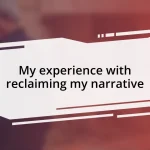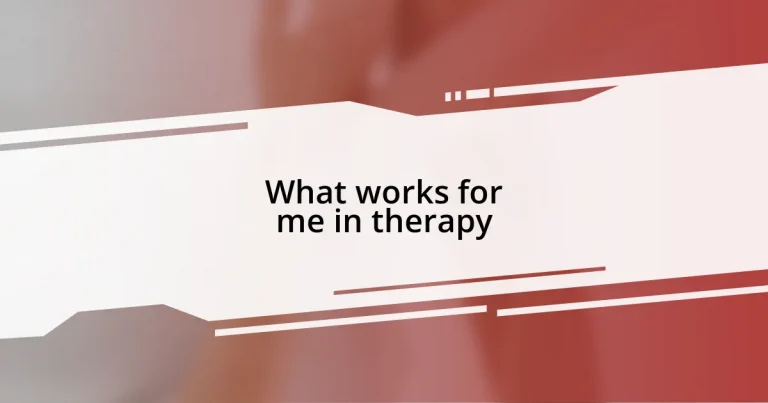Key takeaways:
- Therapy is a non-linear journey, filled with setbacks and valuable lessons that contribute to personal growth.
- Setting specific and actionable therapy goals enhances focus and motivation, making the therapeutic process less overwhelming.
- Building trust with a therapist is essential for vulnerability and deeper emotional exploration, fostering a safe space for healing.
- Effective communication, including active listening and feedback, transforms the therapeutic experience and promotes self-discovery.

Understanding my therapy journey
My therapy journey has been a mosaic of experiences, each piece contributing to my understanding of myself. I vividly remember my first session, sitting in an unfamiliar office, feeling a swirl of nerves and expectations. It made me wonder—how could talking to a stranger really help me unravel the complexities of my mind?
As I progressed, I found moments of clarity that sparked profound realizations about my past. There was a session when I broke down thinking about childhood memories that I’d buried. That emotional release felt like shedding a heavy coat, and I asked myself, what if I had approached those feelings sooner?
Realizing that therapy isn’t a straight path was a comforting yet challenging insight. Each setback felt like a step backward, but looking back now, I see those moments as crucial learning experiences. It makes me think—how often do we view our progress in such binary terms, when growth is really a winding road filled with valuable lessons?

Identifying my therapy goals
Identifying my therapy goals has been a crucial part of my journey. At first, I floated through sessions without a clear direction, sharing thoughts and feelings as they came. But I soon learned that having specific, actionable goals helped me stay focused and motivated. I remember one week when my therapist encouraged me to define what I truly wanted to achieve. I reflected deeply and settled on goals like improving my self-esteem and managing anxiety.
I found it helpful to break down my big goals into smaller, more manageable steps. Here’s a list of the goals I identified during my sessions:
- Cultivating self-awareness through daily journaling
- Developing healthy coping strategies for anxiety
- Strengthening personal boundaries in relationships
- Enhancing communication skills
- Working toward a more positive self-image
This approach not only clarified my path but also made the process feel less overwhelming. Each small win, from writing down my feelings to standing up for myself, became a celebration rather than just another task. I cherish those moments of achievement, as they reaffirm my commitment to personal growth.

Techniques that resonate with me
One technique that truly resonates with me is mindfulness practice. I recall a session where my therapist guided me through a simple breathing exercise. As I focused on my breath, a rush of calm enveloped me, allowing me to detach from racing thoughts. That moment taught me the power of grounding myself in the present. Mindfulness is about tuning into our emotions without judgment, and I’ve found it incredibly liberating—like stepping outside during a snowfall and just experiencing the moment.
Another approach that has deeply impacted my journey is cognitive behavioral therapy (CBT). This technique helps me challenge negative thoughts and replace them with more balanced perspectives. I remember grappling with a particularly harsh self-critique during a tough week. My therapist prompted me to re-evaluate my thoughts, and it felt like pulling back the curtain on a dark room. Transforming self-doubt into constructive feedback has been a game changer for my self-esteem. I couldn’t believe how much of my internal narrative was shaped by outdated beliefs.
Lastly, I’ve discovered the value of art therapy. Expressing my feelings through drawing and painting has brought a new dimension to my healing. I often find myself exploring my emotions visually, creating without the pressure of ‘perfection.’ It’s liberating! One painting represents a chaotic time in my life—brilliant colors swirling together, yet it exudes energy and movement. This freedom in creativity lets me process emotions in a way that words sometimes fail to express.
| Technique | Key Insight |
|---|---|
| Mindfulness | Grounding in the present moment to detach from racing thoughts. |
| Cognitive Behavioral Therapy (CBT) | Challenging negative thoughts and shifting perspectives for improved self-esteem. |
| Art Therapy | Using creative expression to process emotions beyond verbal language. |

Building trust with my therapist
Building trust with my therapist has been an essential foundation for my therapeutic journey. I can recall my early sessions feeling hesitant and guarded, unsure of how much to share. It wasn’t until I noticed my therapist’s genuine warmth and non-judgmental demeanor that I started to feel safe. Trust, I realized, isn’t just about confidentiality—it’s about feeling understood and valued.
One transformative moment occurred when I decided to open up about a painful childhood memory. My heart raced, and I wondered if I’d be met with discomfort or scrutiny. Instead, my therapist listened intently, reflecting my feelings back to me with compassion. This experience deepened our connection and made me appreciate the importance of vulnerability in building trust. Have you ever experienced that unexpected moment of relief when you finally share something weighing on your heart? It’s like releasing a balloon into the sky; it lifts the burden, making space for healing.
Additionally, I found that consistency played a big role in establishing trust. Attending sessions regularly allowed me to see my therapist not just as a professional, but as a steady guide through my emotional landscape. The more I returned, the more I felt like I was part of a partnership—a collaborative effort toward growth. This sense of reliability is something I appreciate deeply; it’s reassuring to know that I have someone by my side as I navigate my feelings and experiences. In reflecting on my path, I can’t help but ask: how does building trust with a therapist impact your willingness to delve deeper into your own emotions? For me, it opened doors to a more honest and enriching therapeutic experience.

Effective communication in therapy
Effective communication in therapy has been a revelation for me, transforming the way I express my thoughts and feelings. I remember a particular session where my therapist encouraged me to articulate not just my worries but also the underlying emotions behind them. Suddenly, I found that naming those feelings brought clarity and relief—not just for my therapist to understand, but for me to comprehend my own emotional landscape. Have you ever felt a weight lift when you simply put your thoughts into words? It’s like turning on a light in a dim room.
Moreover, I’ve come to appreciate the power of active listening. In one session, as I shared a particularly challenging event, my therapist’s presence felt palpable—even in silence, it was as if she was absorbing my words deeply and thoughtfully. This attentive engagement invites a safe space where I can explore my vulnerabilities without fear of being dismissed. How important do you think it is to feel heard in these moments? For me, it’s everything; when someone listens actively, it fosters a connection that encourages deeper self-exploration.
Lastly, I value the role of feedback in our conversations. After sharing insights or revelations, my therapist often provides gentle reflections that challenge my perspective. In one instance, she highlighted how I often dismissed my achievements, urging me to recognize the hard work behind them. I found this feedback not only thought-provoking but empowering—it pushed me towards self-acceptance. Have you experienced those “aha” moments in therapy? They can be pivotal, unlocking new paths of understanding and growth. Effective communication isn’t just about talking; it’s about engaging in a meaningful dialogue that promotes healing and self-discovery.

Strategies for self-reflection
Self-reflection has played a critical role in my therapeutic process, allowing me to gain deeper insights into my feelings and behaviors. One strategy I’ve found effective is journaling. Each night, I take a moment to jot down my thoughts and emotions from the day. This ritual helps me pinpoint patterns and triggers that I might otherwise overlook. Have you ever noticed how putting pen to paper can uncover hidden thoughts? It’s like shining a flashlight in a dark room.
Another powerful technique is mindfulness meditation. During my sessions, I sometimes practice being present with my feelings without judgment. I remember one instance when I felt a wave of anxiety wash over me; instead of resisting it, I simply sat with that feeling. By acknowledging my emotions without trying to change them, I discovered a sense of calm that I didn’t know was possible. How often do we rush to escape uncomfortable feelings instead of exploring them? In my experience, embracing them can lead to meaningful insights.
Finally, seeking feedback from trusted friends has been a game changer. I occasionally ask my close friends how they perceive me, especially during significant life moments. It can be uncomfortable to hear differing viewpoints, but this feedback often reveals blind spots in my self-perception. For instance, a friend once pointed out that I tend to minimize my intelligence in group discussions, which made me reconsider how I convey my thoughts. Have you ever been surprised by how others see you? That moment of realization was eye-opening for me and highlighted the importance of outside perspectives in fostering self-awareness.














